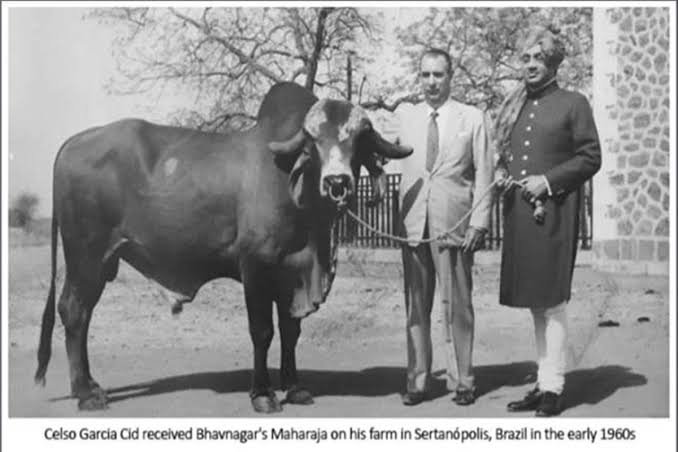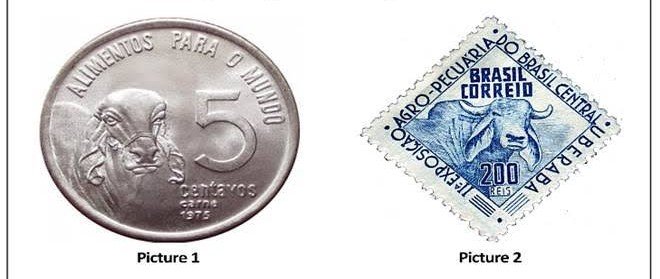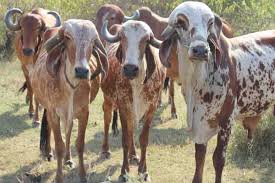By-Chakravarthi.R,
Kamani Dinesh Reddy and Alimudeen.S
Final Year BVSc and AH, Madras Veterinary College , TANUVAS.
Just like people forgetting the superiority of our own traditional values like wishing “VANAKKAM” or “NAMASTE” with folded hands on adapting to Westernisation and now when the world realises the superiority of our own traditions and we start self appraising, its time for the giving Salutation to an Indian Breed ‘GIR’ that saved an economy of a Western Nation, Brazil with the Milk Revolution. Let us see the journey of Gir transformed into Girolando.
Let us first see the breed characteristics of Gir.This breed Belongs to the state of Gujarat. The breed is also known as “Bhodali”, “Desan”, “Gujarati”, “Kathiawari”, “Sorthi”, and “Surati”. This is a world-renowned breed known for its tolerance to stress conditions. Having faced scarcity for a numbers of years, it has the capacity for yielding more milk with less feeding and is resistant to various tropical diseases. Due to their special qualiities, animals of this breed have been imported by countries like Brazil, USA, Venezuela and Mexico, and are being bred there successfully. The animals are of red colour. Many animals have white spots. Variants with different sheds of red are also available. The animals have typically dome shaped fore head and long ears. Reported Average Milk production is 2110 Litre per lactation, there are reports of cows producing about 5000 Litre per lactation.
Maharaja of Bhavnagar, Gujarat, Krishna Kumarsinhji Bhavsinhji and first Indian Governor of Madras was instrumental in changing the fortunes of the Brazilian dairy industry. In the 18th century, Maharaja gifted a `Gir’ cattle pair to Celso Garcia Cid, an icon in the history of Brazilian livestock and successful entrepreneur. This breed is famous for its down horns and reddish-white coat. The bull gifted was named `Krishna’, after one of the most popular Hindu gods worshipped in India. The animal was gifted in order to increase the milk production in that country.
When Krishna was introduced to Brazil in 1960, it started a genetic revolution that made `Gir’ one of the most valued breeds in the bovine embryo market and spawned a mixed breed. It is estimated that 80 per cent of Brazilian `Gir’ cattle carry genes from the `Krishna’ bull that is now referred to as `Gyr’ which subsequently crossbred with Holstein, a Dutch variety, to create the hybrid ‘GIROLANDO’. This breed grew rapidly across Brazil and contributed to about 80 per cent of the nation’s milk production and was registered officially in 1989 by Brazil’s agriculture ministry. Production and popularity of this breed as been sped up due to its high productivity in terms of fertility and efficiency plus, the efforts of the governmental project for improvement called ‘Program Girolando’. In 1989 the Ministry of Agriculture together with the representing associations, drafted the standards for the breeding of Girolando to be 5/8 Holtein and 3/8 Gir.
BREED CHARACTERISTICS OF GIROLANDO:
The Girolando takes its looks from the Holstein and the Gir, it can be black and white in colour but it can vary depending on the percentage of each in the cross. Their ears are large like Gir. Female Girolando have physiological and morphological characteristics perfect for the production in the tropics (udder capacity and support, size of teats, factors intrinsic to the milk, pigmentation, thermo-regulatory capacity, strong hooves and legs, forage conversion, reproductive efficiency). Girolandos start producing calves at around 30 months, the peak of milk production is at 10 years and they can keep on producing til about 15 years. The interval between births is around 410 days. The average production of milk per lactation is 3,600 kg (two milkings/day) in 305 days, with 4% fat, accumulating a lifetime production over 20,000 kg of milk. Males have adaptability (efficient foraging, resistance to diseases and pests, speed of weight gait), can perform comparable to any specific industrial crossing for meat, when placed in similar situations in breeding. In tests it has shown that average weight gain per day is 1kg, plus it has length and thickness with an even distribution of fat to produce a good carcase.
DESIRABLE TRAITS OBSERVED IN GIROLANDO:
• Hybrid vigour
• Quiet disposition
• Good milk production even in hotter climates
• Adaptability
• Longevity
• Fertility and calving ease
• Meat yield
NOTABLE ACHIEVEMENTS:
 Brazil now has about 40 Lakhs heads of `Gir’ cattle and a well-cared-for `Gir’ cow is capable of yielding an average of 30 to 40 litres of milk a day, and this can even go up to 60 to 70 litres. In recognition of the Gir’s role in the country’s economy, it finds a place on Brazil’s coins and in recognition of Maharaja Krishna Kumarsinhji Bhavsinhji’s contribution to its dairy industry; the country has erected a statue of the late ruler near its Parliament House. The breed is being encrypted in the Brazilian Currencies showing its delicacy.
Brazil now has about 40 Lakhs heads of `Gir’ cattle and a well-cared-for `Gir’ cow is capable of yielding an average of 30 to 40 litres of milk a day, and this can even go up to 60 to 70 litres. In recognition of the Gir’s role in the country’s economy, it finds a place on Brazil’s coins and in recognition of Maharaja Krishna Kumarsinhji Bhavsinhji’s contribution to its dairy industry; the country has erected a statue of the late ruler near its Parliament House. The breed is being encrypted in the Brazilian Currencies showing its delicacy.
A Brazilian Girolando cow called Marília produced 127.57 litres of milk in three milkings during the 34th Milk Sands Tournament to claim the title.
Veterinarians of Venezuela and Trinidad recently on May 7, 2020 proposed that breeding of Girolando cattle in these regions will overcome the disease burden and poor managerial conditions prevailing there.
So on concluding this article, when we keep on admiring a neighbour’s house failing to preserve our own house, our house will be ruined soon. Similarly our native breeds have greater potency in disease resistance which are discovered and utilized by other nations but we keep on admiring the milk yield in case of Jersey and HF cross forgetting their nature of lack of disease resistance and climatic adaptation. We hear stories of farmers providing Environmentally controlled housing to Pure breeds of Jersey and Holstein Friesian in India and getting high milk yield, why not they provide such conditions to Native breeds and check for their production. We have oral reports from people of the native breeding tracts of cows like Amritmahal which is now a draught breed as recognised, had produced protein rich high quality milk sufficient to serve the village and Calf birth weight was about 23 Kg about 15 years back but now only 8 to 11 kgs. Is Westernisation is the reason for poor performance of native breed cattle? This the question that arises, the answer is ‘no’, not really, our breeds in general inherited to traits like disease resistance and sturdiness with lower milk production. Cross breeding may be adapted without affecting the number of Indigenous breeds for which our Government have various Breed Specific Research Centres established in the native tract. However I believe that its duty of every citizen to preserve the Indigenous breeds which are real wealth of the nation.
“Conservation is a cause that has no end. Conserve and preserve Indigenous breeds of cattle else your kid may see them in Zoological parks or Sanctuaries and your grand children may learn them only as specimen.”



